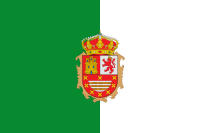|
Vikidia currently has 4,621 articles. Improve it! |
|
Join Vikidia: create your account now and improve it! |
Fuerteventura
Fuerteventura (pronounced [fweɾteβentuɾa]) is a volcanic island, part of Spain, located in the Atlantic Ocean.
Population = Number of the inhabitants[edit | edit source]
in Fuerteventura of Spain there were 107,367 inhabitants
Denonym = name of the inhabitants[edit | edit source]
Demonym of fuerteventura is Mahorero or Maho[Source?]
Brief description[edit | edit source]
Fuerteventura is a subtropical Canary Island. The variety of the climatic and vegetational zones of this Island make it suggestive and fascinating, giving it a great variety of landscapes. Here you find cliffs hundreds of meters high, desert areas is often immersed in a carpet of clouds.
Flag/seal[edit | edit source]
Celebrations[edit | edit source]
Bajada de la Virgen de los Reyes, Feste della Bajada de la Virgen de las Nieves, bajada de la Virgen de Guadalupe
Popular monuments/places[edit | edit source]
Barlovento Beach - La spiaggia di Cofete - Costa Calma Beach ...
Nickname[edit | edit source]
Fuerteventura literally means "fortune" but is translated by some as "Strong Wind".
Particularity[edit | edit source]
The real peculiarity of Fuerteventura is that the annual sunny hours, equal to about 3000 units, make it the sunniest in the world. This island holds the world record of the sun! But not only: Fuerteventura is considered the most ancient island from the point of view of its geological formation.
Gastronomy = a particular dish[edit | edit source]
Fuerteventura cheese and Papas arrugadas with mojo
Quotation in literature or ....[edit | edit source]
This small town guarded by the Mountains of Silence is a real gem: founded in 1404 by Juan de Bethencourt, it soon became the capital of the Canary archipelago. Traces of its past remain in the cultural richness of this small town: the Iglesia of Santa Maria and the Casa Santa Maria, the noble palaces, the bourgeois villas and the Archaeological Museum.[Not clear]
Notes[edit | edit source]
